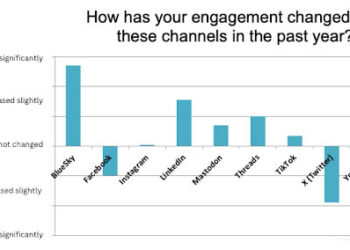 Steven Levy has an interesting piece in Wired on the imminent ubiquity of real-time video. He’s right — the Internet is about to morph into a new form, but its implications are not fully in view yet. It’s rare that the emergence of a new platform looms so visibly on the horizon, tempting a publisher with what to make of it. Such a platform invites both specific speculations (“Let’s create video conferences for the subscribers to our oncology journal”) and a more general exploration of the underlying physics of a new medium. What is different about real-time video? How does the fact that it is soon to be ubiquitous matter?
Steven Levy has an interesting piece in Wired on the imminent ubiquity of real-time video. He’s right — the Internet is about to morph into a new form, but its implications are not fully in view yet. It’s rare that the emergence of a new platform looms so visibly on the horizon, tempting a publisher with what to make of it. Such a platform invites both specific speculations (“Let’s create video conferences for the subscribers to our oncology journal”) and a more general exploration of the underlying physics of a new medium. What is different about real-time video? How does the fact that it is soon to be ubiquitous matter?
Some context-building. Real-time video has been with us for some time now, as the millions of users of Skype can attest, but it is about to become more prevalent for several reasons. One reason is the recent acquisition of Skype by Microsoft, which will be pushing Skype out through its entire commercial network. But even without Skype we have the astonishing growth of smartphone use. It astounds me that I can watch a YouTube video on my phone — though YouTube, of course, is not real-time. We will shortly be video-chatting with everyone, and we will do it wherever we go, no longer chained to a desktop system.
Some years ago I was on the Board of a video-conferencing software company. This was pre-iPhone; the game was to market the company’s desktop video solutions to displace the dedicated hardware that, despite their staggering price, dominated the corporate market. It was pretty cool to get into some of the engineering of this — the need for compression and decompression technology, the cost of bandwidth, the reasons to move to peer-to-peer solutions, etc. This English major could not help but ask over and over: How did these guys dream this up? And not only that; they actually went out and built it!
But even then it was clear that there was an inherent limitation to this technology in that you had to go to the machine; the machine did not come to you. Consequently, you had to be fairly conscientious about scheduling a conference and could not simply have a spontaneous video meeting without interrupting someone. This in turn meant that very brief conferences were rare, as it took some effort to schedule a mutually agreeable time. This is what I mean by the physics of a medium, things like the inherent need to schedule a conference in advance. A mobile solution, however, would enable greater flexibility and casualness in arranging the meeting time (“Ping me when you are walking to the parking lot after work”), but it would have a different set of tradeoffs. For example, how would you have a group videoconference on the small screen on a mobile phone?
Desktop video was never more than a geek’s toy until Skype came along, but even Skype is still quasi-geeky. Now that we have smartphones — now that smartphones are all but ubiquitous — mobile videoconferencing will become mainstream. Today we go to the supermarket and phone or text a spouse about whether to buy the broccoli or the cauliflower, but soon we will turn our smartphone cameras to the display of tomatoes so that hubby can select his own while standing on the platform of the Bronxville train station.
What will we do with this new medium? When you first begin to examine any new medium, its limitations seem larger than its affordances. But truly creative people see beyond that. To my mind, the most amazing media invention in recent years was Evan Williams’s insight that the 140-character limitation of a standard text message was perfect for a certain kind of short message, what we now know as a tweet. Over time, the affordances of that 140-character limitation have given us a global network of curated news feeds, where anyone can aggregate a number of “curators” and have links to the world’s information resources delivered to the palm of your hand 24 hours a day. Williams, by the way, was also the cofounder of Blogger. Lightning strikes twice.
For publishers the limitations of real-time video are pretty large. Publishers are very good at creating fixed content, but real-time video is more of a communications medium, more about back-and-forth than about the version of record. On the other hand, we have been watching as publishers probe mobile platforms for some time. Their work typically falls into stages:
- Use limited mobile phones to distribute metadata. In the days when we were all getting our email on Blackberries, abstracts and tables of contents were being pushed to our phones. In that early stage, the mobile platform was used mostly for marketing.
- Reconfigure content for mobile presentation. Many publishers are doing this now, with tablets getting an enormous amount of attention. Some publishers see in this a way to monetize content in new ways, some view it simply as another way to display content that customers have already paid for. Either way, few publishers are ignoring the mobile platform for the presentation of fixed content.
- Create content and services that are native to the mobile platform. Elsewhere I have called this the “face-down publishing paradigm.” In this paradigm content is continually updated (making it difficult to pirate) and designed specifically for consumption on mobile devices. We are early in this phase now, but it will become a bigger and bigger part of professional and academic publishing in the coming years.
Ubiquitous real-time video adds something new to the face-down paradigm, however, in that (a) the mobile screen is but one of what could be many, and (b) the mobile device (I am finding it increasingly difficult to call my phone a “phone”) is also being used as a sensor, not just for human communications.
Concerning (a), the multiplicity of screens, imagine a network of devices all communicating with real-time video. Web cameras are placed in laboratories (hard to escape the Orwellian creepiness) and communicate to attendants at desktops and to team members wherever they may be, and “wherever” now means wherever you have a phone with you, which is everywhere. Conferencing takes place much as conference calls do today, with some people sitting in offices in front of desktops and some sitting in a parking lot hanging on their cell phones. The question is, How do we take advantage of this as a publishing medium?
With regards to (b), we are potentially in the area of sensor publishing, where the relationship between human and device has been reversed. In a traditional scenario, the phone is our tool, our instrument: it extends ourselves into the world. But with sensor publishing, people are hosts, carrying phones around so that phones can do their job of absorbing information from the environment. Sensors can detect many things: heat, radiation, humidity, and sound, among other things. They will use real-time video to detect and transmit light, where it can be analyzed by either humans or machines.
The physics of real-time video suggests that phones can be massively deployed to gather data — the crowdsourcing model. For a publisher, there may be opportunities in new kinds of primary materials, where the value is in properly deploying the crowd (you need a statistically relevant sample) and in analyzing the data. It is likely that the new medium of ubiquitous real-time video will find its first applications in the consumer market, as do so many things nowadays, and then will migrate to applications of greater interest to professionals and researchers.
However this medium takes shape, the time to begin thinking about it is now, when it is young and experimentation can take place outside the context of marketplace competition. Waiting until the medium is established means playing catch-up — at great cost and without all the fun of doing something first.
Discussion
5 Thoughts on "The Emergence of a New Platform: Ubiquitous Real-time Video"
Surely this development has potential to higher education publishers? Some of the heaviest users of mobile devices are secondary school students. A real time video supplement to learning would be interesting.
It really does seems to be moving towards a ‘wow’ moment in cultural terms (pace Kent’s mpost yesreday). I remember two years ago watching a live FA Cup football (soccer) game with my five year old son on my phone and suddenly being struck by the wonder of this moment.
LIVE football; on a PHONE. He was 5.
I had a go-kart at that age.
Then losing track of the game as I wondered when bandwidth would allow this to really take off. And where it would take us then.
Subsequently the iPad has come along. Facetime is growing. It’s moved from the passive live experience to an interactive one. Chuck in a dose of virtual reality as well and well…
Wow indeed.
For a sobering, if fictional, view of the world of ubiquitous sensor-based video and computing, try Neal Stephenson’s Snow Crash, c2000 from Random House. I suspect many regular readers of this column have already taken the plunge.
If I were an investor in the airline industry, I would be worried. The ubiqiuity of video conferencing will have significant effects on business travel in the future.


